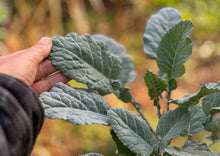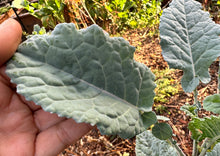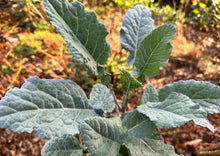Do you live in a colder climate and wish you could grow Perma Collards? This cold-hardy collard is just for you! This awesome Perma Collard was originally bred in Michigan by Ken Oikos. He has reported that it consistently can handle down to 0 degrees F and has even survived -18 degrees! Wow, that's a seriously resilient collard. We love it for its tasty and beautiful silvery collard leaves. (Brassica oleracea)
*Rooted plants of this variety will be an exact clone of the mother. Seeds will exhibit genetic diversity and you'll see wonderful variations in your plant babies.
We also carry 3 other varieties of Perma Collards: Constant Collard, Crocodile Collard, & Green Tree Collard.
Why We Love It
Here are some of the reasons why we love the Cold-Hardy Collard...
1) COLD-TOLERANT - This variety was specifically selected for its resistance to cold and should reliably over-winter in areas that get down to 0 degrees. With a bit of mulch, it may be able to handle even colder and grow back from the roots in the Spring.
2) SILVERY SHEEN - This collard is striking because of its silvery coloring of its leaves. In nature, this silvery coating helps plants tolerate more extreme cold and heat conditions.
3) GREAT TASTE - Like all of our Perma Collards, the Cold-Hardy Collard has a beautiful, true collard taste and is delicious in soups, stir fries, and dehydrated as chips.
How to Grow It
Here's how to grow Cold-Hardy Perma Collards:
| SUN | FULL SUN |
| MOISTURE | LIKES GARDEN MOISTURE |
| GROWING ZONES | PERENNIAL OUTDOORS IN USDA ZONES 7-10, CUTTINGS CAN BE OVER-WINTERED INDOORS EVERYWHERE ELSE (Not sure? Find your growing zone here) |
| SIZE | 3-6 FEET TALL & 3 FEET WIDE |
| GROWING |
FROM CUTTINGS: We like to root cuttings in 4" or 1 gallon pots. Fill with moistened potting soil. Simply bury the cutting halfway in the soil. Tamp around the cutting to secure. Water occasionally to keep the soil moist. That's it! They root super easily and you should see new leaves start popping in 4-8 weeks. We root outside year-round in zone 9 and above. If you're colder than this, keep your potted cutting on a window sill until Spring. Let us know if you need any support. We're here for you! FROM SEEDS: Start indoor in plug trays 4-6 weeks before last frost date. Seed ¼’’ deep and keep moist. Germ in 7-14 days. Ensure steady moisture and a good light source to reduce stretching, which creates weak stalks. Plant out or pot up once seedling has a strong root structure. FROM ROOTED PLANT: We trim all of the leaves except for the top leaf for shipping to prevent dehydration. Once you plant into moist soil, it will spring to life for you and immediately start growing leaves. It's best not to let your plant flower as it's getting settled into its new home. Trim off any flowers for the first few months. It will seem to grow slowly for the first couple months as the roots settle in, and then it will boom with growth! PRO TIP: The key for this wonderful, branching perennial green is to harvest often! It will allow for optimal air flow, which will keep your collards happy and healthy. If you live in a cooler growing zone, take a branch cutting in the late Fall and pop into a pot and bring indoors for the winter. You can plant out again in the Spring. |
Here are some pruning tips below:
How to Harvest & Use It
Harvest the outer, largest leaves. We suggest harvesting 1/3 or less of the leaves at a time so the plant can continue to gather sun and photosynthesize. Your Cold-Hardy Collard will pop up a flower stalk in the spring. The immature flower buds can be harvested and eaten just like broccoli (it's the same family). While it's flowering, you'll notice that it doesn't make as many leaves. After the plant is finished flowering, cut off the flower stalks and it will increase its leaf production again and give you leaves all summer, fall, and winter. In areas where it gets really cold, this plant may go winter-dormant and then spring back to life from the roots in the Spring.









